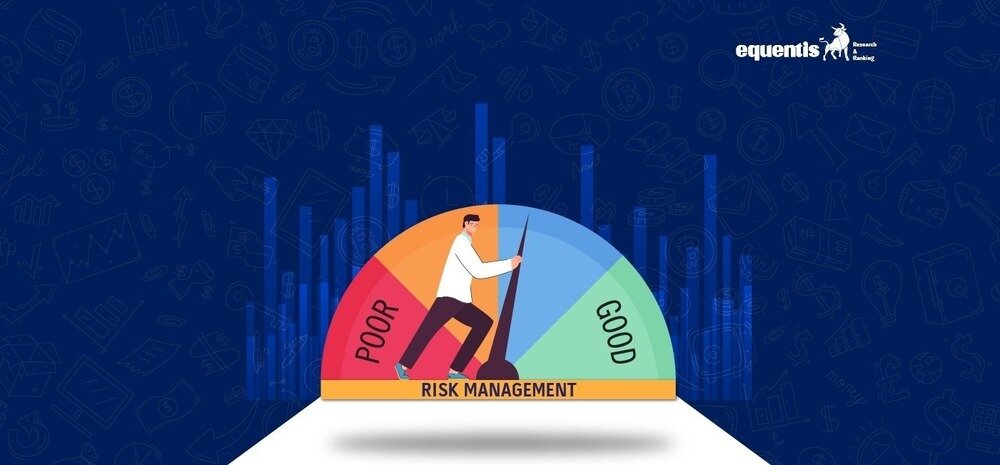When we step into the stock market, many warn first about the volatility of the dynamic market. It indicates how essential it is for every investor to grasp one more concept and the techniques of investing- the art of risk management. Some exploit the market swings, while others find it challenging. Many turn to diversification to tackle the risk-related challenges, but is that the only solution available? While diversification helps, other strategies also aid risk management. What tools? We’ll explore them shortly. But first, let’s define both risk and risk management.
What is Risk Management?
Risk Management Definition: A Simple Overview
Risk management is the process of identifying, assessing, and addressing risks to minimize potential financial losses. In the context of the stock market, it involves implementing strategies that protect your investments against market volatility, poor investment decisions, or unforeseen events.
Risk Management Meaning in the Context of Share Market Investments
In share market investments, risk management ensures that investors can safeguard their portfolios while maximizing returns. It balances the relationship between risk and reward, creating a disciplined approach to trading and investing.
How Effective Risk Management Protects Your Portfolio
Proper risk management can:
- Reduce the impact of market fluctuations.
- Protect capital during downturns.
- Enhance decision-making by aligning investments with financial goals.
How to Implement Risk Management in Share Market
1. Assess Your Risk Tolerance Before Investing
Understanding your financial goals and ability to absorb losses is the first step in implementing effective risk management.
2. Monitor Market Conditions Regularly
Stay informed about economic indicators, geopolitical events, and market trends that could impact your investments.
3. Use Technical and Fundamental Analysis to Manage Risk
Leverage fundamental analysis to evaluate a company’s financial health and technical analysis to time your trades effectively.
4. Rebalance Your Portfolio Periodically
Adjust your portfolio to maintain the desired asset allocation and respond to changes in market conditions.
Benefits of Risk Management in Stock Market
1. Minimizing Losses During Market Downturns
Proactive risk management strategies help cushion the impact of market downturns, preserving your capital.
2. Maximizing Long-Term Returns by Avoiding Panic Selling
A disciplined approach prevents emotional decisions during volatile periods, ensuring long-term profitability.
3. Building Confidence as an Investor Through Disciplined Practices
Effective risk management instills confidence, enabling you to make informed decisions and stay committed to your investment strategy.
Types of risk management:
- Market Risk Management: Also called financial risk management, deals with potential losses from changing market conditions like interest rates, inflation, and currency exchange rates. Strategies such as diversification and hedging are used to reduce these risks.
- Credit Risk Management: This process focuses on potential losses when borrowers can’t meet financial obligations. It involves evaluating borrower creditworthiness and using measures like collateral or insurance to handle defaults.
- Operational Risk Management: These are necessary due to the possibility of risks arising from internal failures, such as system errors or human mistakes. Controls and procedures, including contingency plans and disaster recovery, are implemented to minimize these risks.
- Liquidity Risk Management: This concerns the risk of being unable to turn assets into cash when needed. Managing liquidity risk means keeping enough cash reserves and establishing quick asset-to-cash conversion processes.
- Reputational Risk Management: It involves managing risks of potential losses due to harm to a company’s reputation. Actions like social media monitoring and fast responses to negative feedback are taken to mitigate this risk.
- Legal and Regulatory Risk Management deals with losses from not complying with laws and regulations. Managing this risk requires implementing controls and processes to ensure compliance with legal requirements.
Common Mistakes to Avoid in Risk Management
1. Overconfidence in Specific Stocks or Sectors
Relying heavily on one stock or sector increases vulnerability to downturns. Diversification mitigates this risk.
2. Ignoring the Importance of Stop-Loss Orders
Failing to use stop-loss orders can lead to significant losses, especially in volatile markets.
3. Failing to Adjust Strategies as Market Conditions Change
Adapting your risk management strategies to evolving market conditions is crucial for sustained success.
Financial Risk Management Strategies Used in the Stock Market:
- Diversification:
Diversification, the first strategy, is like having a safety net for your portfolio. By spreading your investments across various stocks, sectors, industries, and asset classes, you’re not putting all your eggs in one basket. This can help reduce the adverse impact of a single poor-performing stock or market changes affecting the other better-performing stocks.
- Position sizing:
Allotting appropriate position sizing is critical. Risking too much capital on one trade can result in significant losses. Traders often use a percentage of their portfolio or a fixed amount as a guide to limit exposure per trade.
- Stop loss orders:
Stop-loss orders allow you to set a price level at which you’ll sell stock to limit losses. If the stock price hits or drops below this level, the order gets executed automatically, curbing further losses.
- Research and analysis:
Thorough research is essential for informed trading decisions. This involves studying company fundamentals, market trends, financial statements, news, and technical indicators. Understanding stock price drivers leads to wiser choices and fewer unexpected losses and aids in investment risk assessment.
- Risk-reward ratio:
You can evaluate risk-reward ratios to weigh potential gains against losses for each trade. A good ratio suggests potential rewards outweigh risks. Establishing a minimum acceptable ratio can help you pick trades with better return potential.
- Allocating Risk Capital:
It’s crucial to allocate a portion of your capital as risk capital. This portion represents the money you’re willing to risk in stocks while keeping the remainder in safer investments. Limiting risk capital exposure helps avoid significant losses and maintain financial stability.
- Hedging:
Hedging uses financial tools like options or futures to balance potential losses. For instance, an investor might buy put options (a type of derivatives contract) on a stock to guard against losses if its price falls.
- Rupee-cost averaging:
Rupee-cost averaging means investing the same amount regularly in a company, regardless of the market. It helps investors benefit from market ups and downs by buying more shares when prices are low and fewer when prices are high.
- Managing portfolio actively:
Active portfolio management involves continuously monitoring and adjusting the portfolio per changing market conditions. This approach evaluates market trends, company performance, and economic indicators to make informed investment decisions.
- Pairs Trading:
Pairs trading entails buying stocks of one company while simultaneously short-selling stocks of another in the same industry to mitigate price volatility risk through exploiting sector-relative price movements.
- Beta Analysis:
Beta measures a stock’s movement relative to the overall market. A high beta suggests the stock is volatile, rising sharply in a market upswing but falling steeply in a downturn. Conversely, a low beta implies stability akin to a calm boat.
For instance, consider Stock A (beta 1.5) and Stock B (beta 0.8). If the market rises by 10%, Stock A might climb by 15%, whereas Stock B might only increase by 8%. Understanding beta helps predict how much a stock will fluctuate with the market.
Conclusion: Why Risk Management is Essential for Successful Investing
In summary, putting your stakes in short-term or long-term investment stocks can lead to financial growth, but managing the risks is crucial. Whether through diversification, hedging, or beta analysis, these financial risk management methods protect your capital and help gauge risk. Investing is inherently risky, so make informed decisions based on your financial situation and consult a SEBI-registered advisory to choose the right strategy for your portfolio.
FAQ
What do you mean by risk management?
According to various definitions, risk management is a three-step process. It entails identifying threats or downsides to an investment, analyzing them using standard mathematical methods or other approaches, and developing measures to mitigate them.
What are the five stages of risk management?
The stages of risk handling involve the following-
Identifying risks
Assessing the degree of risk
Strategizing to mitigate the risk
Monitoring and reviewing
Proactive changes when necessaryWhat are the five principles of risk management?
The five main principles of risk management are-
Risk identification
Risk analysis
Evaluating and prioritizing the risks
Controlling and mitigating risks
Risk monitoring and reviewing
How useful was this post?
Click on a star to rate it!
Average rating 4 / 5. Vote count: 1
No votes so far! Be the first to rate this post.
I’m Archana R. Chettiar, an experienced content creator with
an affinity for writing on personal finance and other financial content. I
love to write on equity investing, retirement, managing money, and more.
- Archana Chettiar













